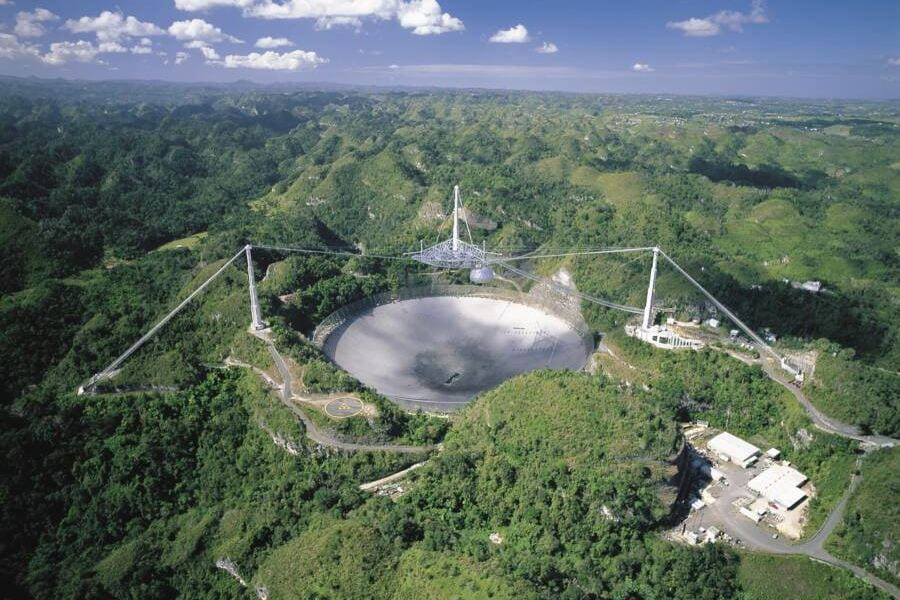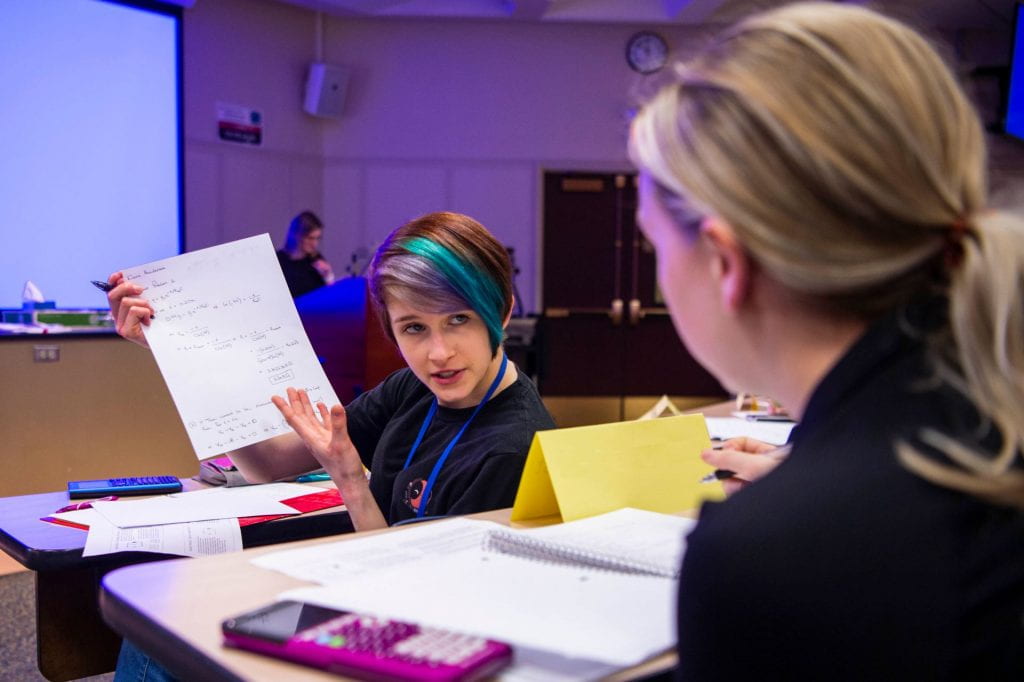
Contents
CHAIR’S WEEKLY MESSAGE
“Speak Up”
Go outside tonight. Try to find a really quiet place. Now, sit. Close your eyes. Listen.
Can you hear them?
Well, NANOGrav thinks they can.
To quote the author Douglas Adams,
“The Universe is an unsettlingly big place, a fact which for the sake of a quiet life most people tend to ignore. Many would happily move to somewhere rather smaller of their own devising, and this is what most beings in fact do.”
“The Hitchhiker’s Guide to the Galaxy”
Out there, in the vastness of the cosmos, are a large number of galaxies that, over billions of years, have merged together. It’s believed that most, if not all, of these galaxies have a supermassive black hole at their heart, a monstrous region of spacetime containing the masses of 100 million stars. When the galaxies merged, their supermassive black holes should have gone into orbit around each other. Their slow collapse toward a merger into one massive singularity would take immense stretches of time and in the process would make spacetime itself shudder with gravitational waves.
Like low frequency chimes, these orbiting supermassive black holes would make the universe ring with with a chorus of gravitational waves.
Can you hear them?
In this issue of the Friday Newsletter, we are fortunate to have the expert perspective of our own Prof. Joel Meyers on the recent claim by the NANOGrav pulsar timing array experiment that they have evidence of this cosmic spacetime din. In addition, we look to the next event in the Department Speaker Series, which will be rich in deep learning and applications to high-dimensional problems in collider physics. We also have a nice physics problem to tease everyone’s brain over the next week!
Sincerely,

Stephen Jacob Sekula Chair, Department of Physics |
DEPARTMENT VIEWS
A Song of Supermassive Black Holes
by Prof. Joel Meyers
The NANOGrav (North American Nanohertz Observatory for Gravitational Waves) collaboration recently published the results of a search for stochastic background of low frequency gravitational waves based on 12.5 years of data. For the first time, the analysis of this type of data has shown an intriguing hint of a non-zero signal that is roughly consistent with that expected from the gravitational waves produced by the coalescence of supermassive black holes throughout the Universe. The signal is not yet significant enough to definitively claim that it represents a detection of a long-wavelength gravitational wave background, though future data from NANOGrav and similar efforts should be decisive within the next few years.
NANOGrav is a type of a coordinating observing campaign known as a Pulsar Timing Array. NANOGrav scientists use the Green Bank Telescope in West Virginia and the Arecibo Observatory in Puerto Rico (until its shocking recent collapse captured in a stunning video) to monitor the very regular radio pulses from astrophysical objects known as pulsars situated throughout the Milky Way Galaxy. Pulsars are very rapidly spinning neutron stars that host strong magnetic fields which cause beamed emission from their poles. Observers here on Earth see pulsar emission only when the radiation is beamed toward us, much like the light from a lighthouse is seen by sailors only when the beam illuminates their ship, and as such pulsars appear to undergo regular bursts of radio emission. The extreme regularity of these radio pulses allows scientists to use pulsars as very precise clocks spread throughout the Galaxy. Pulsar timing arrays are used to monitor the radio bursts from many pulsars over several years, and scientists look for tiny deviations in the expected pulse arrival times. (For an excellent overview of Pulsar Timing Arrays and NANOGrav, see the recent SMU Physics seminar by Dr. Stephen Taylor.)
Gravitational waves passing through the Earth stretch and squeeze space, effectively altering the light travel time between distant pulsars and the Earth. As a result, gravitational waves are expected to produce a correlated shift in the arrival times of radio pulses from pulsars. The nature of gravitational waves predicts a specific (quadrupolar) pattern of correlation. While the data from NANOGrav has demonstrated that there is a correlated shift to the pulse arrival times, the signal is not yet strong enough to demonstrate that it has this characteristic pattern. More observing time and correlation with other pulsar timing arrays (including the Parkes Pulsar Timing Array in Australia and the European Pulsar Timing Array) should make it possible to either confirm or rule out the signature correlation pattern expected from gravitational waves.
Pulsar timing arrays are sensitive to very low-frequency gravitational waves, with periods on the order of a year. This frequency range cannot be directly probed with experiments like LIGO and VIRGO, which are sensitive to higher frequency gravitational wave signals. Pulsar timing arrays are currently the most precise tools we have to search for nanohertz gravitational waves, but there are other techniques that can complement the ongoing efforts. Gravitational waves cause a characteristic oscillation in the apparent positions of distant stars, and so very precise astrometric measurements provided by experiments like Gaia can be used to search for long wavelength gravitational waves. A novel method using observations of strongly lensed repeating fast radio bursts (for more about fast radio bursts, see recent SMU Physics Seminar by Kendrick Smith) has also recently been suggested by SMU physicists: undergraduate Noah Pearson, postdoc Cynthia Trendafilova, and Professor Joel Meyers (https://arxiv.org/abs/2009.11252).
Gravitational waves in the nanohertz band are expected to be produced by binary systems of supermassive black holes that are expected to form as the result of major galaxy mergers throughout the Universe. There are expected to be so many of these events that the Universe should constantly be filled with the low hum of the gravitational waves produced in this process – a stochastic gravitational wave background.
Supermassive black holes have been featured prominently in the news in the past few years. In 2019, the Event Horizon Telescope collaboration produced an image of the environment of the supermassive black hole at the center of the M87 galaxy. The 2020 Nobel Prize in Physics was awarded in part for the observations that confirmed the presence of a supermassive black hole at the center of the Milky Way. Results like those from NANOGrav add to the growing list of ways that we can study these astrophysical behemoths. Astrophysicists including SMU Professor Krista Lynne Smith use these and other measurements to study supermassive black holes and the effects they have on their host galaxies (see Professor Krista Lynne Smith’s recent SMU Physics Colloquium).
If the signal seen in NANOGrav data is confirmed to be due to gravitational waves, it will provide an important new piece of information about the population and history of supermassive black holes. Furthermore, it provides an additional example of how gravitational wave observations can be utilized to reveal the secrets of our Universe.
Prof. Joel Meyers is an Assistant Professor of Physics at SMU and an expert in theoretical cosmology and astrophysics. In addition to his research, he teaches a range of courses from General Physics I through graduate-level Quantum Field Theory.
Networking Event for Women in Physics to Mark International Day of Women and Girls in Science
On Thursday, February 11, the physics department is proud to support a virtual event intended to support women involved in our physics program with a networking opportunity. This will help mark the International Day of Women and Girls in Science. The event is organized by Prof. Durdana Balakishiyeva, Prof. Jodi Cooley, Prof. Allison Deiana, and Prof. Krista Smith. If you are interested in participating, please reach out to one of the organizers for more information!
Dr. Ben Nachman (Lawrence Berkeley National Laboratory) presents a Seminar on Applications of Deep Learning in Handling High-Dimensonal Data from Particle Colliders
The next event of the Spring 2021 Department Speaker Series is on Monday, February 8, at 4pm. We welcome Dr. Ben Nachman (LBNL) to speak on the problem of high-dimensionality in particle collider data and applications of deep learning to address the need to analyze that data. Examples for application will focus on the Large Hadron Collider and the forthcoming Electron-Ion Collider.
Miss a Colloquium or Seminar? Don’t Panic … They’re Recorded!
You can catch up on the Spring 2021 (and Fall 2020!) Physics Speaker Series by checking out your favorite subjects from archives! Explore supermassive black holes, the new Electron-Ion Collider planned for construction in the U.S., new ideas about dark matter or other novel particles or forces, or the basic research needs for future scientific instrumentation in HEP … all from your personal devices! Enjoy our archive of the Physics Speaker Series Talks below.
FACULTY NEWS
If you have something to share please feel free to send it along. Stories of your activities in research, the classroom, and beyond are very welcome!
Faculty Meetings for Spring 2021
(By Stephen Sekula, Department Chair)
Faculty are busy people, balancing research, teaching, and service. That makes our schedules pretty incongruent. This is especially true this spring. As a result of mismatches in the schedules of all full-time faculty, we will be forced to have our monthly faculty meetings on different days of the weeks and times so that no one person is overly excluded from participating in the meetings by virtue of class schedules or research meeting obligations. Here is the published schedule for Spring 2021. Connection details are available from Lacey Breaux, and the meetings are intended for full-time faculty only (tenure-line professors or lecturers).
- Wednesday, February 10, 3-4pm
- Thursday, March 11, 4-5pm
- Friday, April 9, 3:30-4:30pm
- Monday, May 10, 11am-12pm
STAFF NEWS
Staff In-Office Schedule for Week of February 8
The in-office staff schedule for the week of February 8 is as follows:
- Monday: Lacey
- Tuesday: Lacey
- Wednesday: Michele
- Thursday: Lacey
- Friday: Michele
Of course, both are always available on Microsoft Teams, by Email, or by phone.
Full staff in-office calendar for February:
STUDENT NEWS
If you have something to share please feel free to send it along. Stories of students in research, the classroom, internships or fellowships, awards, etc. are very welcome!
ALUMNI NEWS
If you are an alum of the doctoral, masters, majors or minor programs in Physics at SMU, or have worked in our program as a post-doctoral researcher, and wish to share news with the community, please send your story to the Physics Department and we’ll work with you to get it included in a future edition.
THE BACK PAGE
The Physics Teacher’s “Figuring Physics”
We leave you this week with some mental exercise: an example of the “Figuring Physics” feature from this month’s “The Physics Teacher” journal! This is good for physicists of all levels, from introductory physics students to seasoned instructors.












